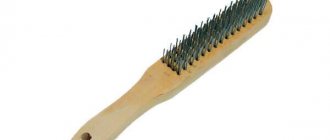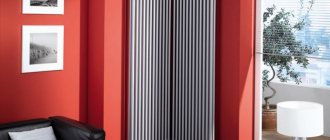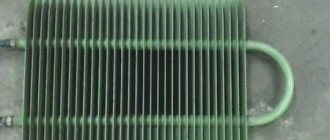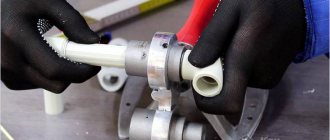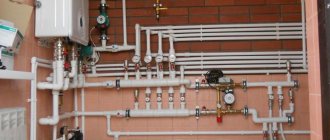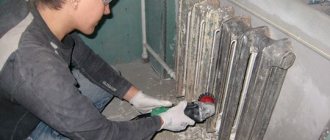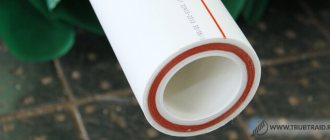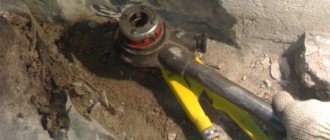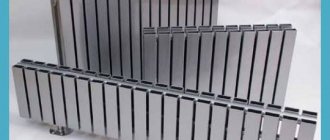Requirements for heating systems
In order not to be mistaken with what paint to paint the heating pipes, you need to know the requirements that it must meet. After all, the heating system is usually affected by rather high temperatures and their differences. In addition to internal conditions, there are also external factors of influence. Therefore, the main characteristics should be as follows:
- resistance to high temperatures - it should not crack or deform;
- anti-corrosion effect: high-quality protection against rust;
- non-toxicity: harmful substances should not be released into the air when the paint is heated;
- resistance to high humidity, aggressive environments and mechanical damage;
- high strength of the coating: it should not peel off from the pipe;
- preservation of the original texture and color over time.
It is necessary to choose a paint designed specifically for painting metal products. Although it will cost more, such a coating that meets the specified conditions will ensure a long service life.
https://youtu.be/Nj6bbt8PIaI
Types of products used
There are various product variants with the required characteristics.
Recently, oil paint for heating pipes is almost never used due to its disadvantages: pungent odor, long drying time, color change under the influence of high temperatures.
The most common types of paints used for heating pipes and radiators are the following:
- acrylic enamels - durable, resistant, giving the surface a glossy shine. However, their disadvantage is an unpleasant odor during the dyeing process, which, however, quickly disappears;
- alkyd enamels - resistant to high temperatures, abrasion, the coating is very durable and uniform. They are distinguished by a wealth of various shades. But their significant disadvantage is a pungent smell that can last up to three days and be felt when the heating is on;
- water-dispersion emulsions should be chosen when odorless paint is needed for heating pipes. They are easy to apply, creating an even coating, dry quickly and do not have an unpleasant odor. It is imperative to see that the marking indicates that it is intended for painting radiators.
You can choose one or another composition depending on the features of its application, the desired color, as well as the subsequent care of the heating system.
Types of paint for heating pipes
- acrylic enamels. The basis of such a paint is made up of organic solvents, which explains the not entirely pleasant smell during its drying. Nevertheless, such a sample will provide a perfectly smooth and glossy surface and will last a very long time;
- alkyd-type enamels. These compounds also emit an unpleasant odor, which can periodically appear in the future with an actively operating heating system. However, such a paint will be very resistant to any mechanical damage and will not change its structure when exposed to high temperatures. Do not forget that on the modern market there is a wide selection of shades of such enamel, therefore, it will not be difficult to choose an option suitable for a particular interior, it will be enough just to study the photos of the samples provided by the manufacturer;
- water-based paints. Painting heating pipes with this composition is the most common option among consumers.This composition does not exude an unpleasant smell, in addition, such paint for hot heating pipes dries out very quickly.
It is also impossible not to mention such an option as oil paint, which, however, is rarely used today for painting pipes.
Preparation for painting
The quality of painting radiators depends on how well you prepare them for this operation. Often, the preparatory stage takes longer than the painting itself, but knowing how to remove paint from the heating pipe using special tools, you can speed it up a little. Preparation for applying the coloring composition is as follows:
- Removing dust and dirt with a wet cloth.
- Removing old layers: apply the rinsing solution to the pipe and cover it with foil. Remove it using a putty knife, a metal brush or a grinder on the drill. It is advisable to protect your nose and mouth with a respirator or gauze bandage, and your hands with gloves.
- Sanding the surface with sandpaper, cleaning the places where there is rust, to the shine of the metal.
- Degreasing with white spirit or some slightly alkaline solution.
- Application of an anti-corrosion primer to the cleaned surface to help the paint adhere better and to prevent rust. An alkyd-based primer is best suited.
The durability and quality of the coating also depends on a good primer. Therefore, choose the one that says it has anti-corrosion properties, otherwise rust will reappear over time.
If the heating pipes in your apartment are metal, use an alkyd-based primer. On a surface that has been prepared taking into account all the requirements.
Now many manufacturers produce paints that already have a primer in their composition, as well as a rust converter. If you wish, you can buy such a composition and not waste time applying the base.
A few tips for coloring
If you have already decided which paint to paint the necessary heating elements, have purchased the right one, also consider a few recommendations in order to get the maximum quality of staining. An important requirement for painting a heating system is its temperature at that moment.
Heating pipes and radiators should be painted when they are cold, that is, in the summer. If there is a need to urgently do this during the heating season, you need to turn off the heat supply for a while.
Surfaces should not be painted hot because at high temperatures it is inconvenient, the layer will lie unevenly, and when it dries, the applied composition may crack and you will have to do the same work again.
Recommendations:
- apply paint evenly using a brush and spray gun;
- make sure that there are no unpainted areas, even where they are not visible;
- start work from the top of the pipeline;
- after applying the first layer, let it dry well and only when it is completely dry, paint it again to get a uniform, beautiful coating;
- if smudges are formed, I will smother them, blend them with a brush or remove them with a cloth.
If you have plastic heating pipes, you don't need to paint them, they look good anyway. However, if you wish, you can apply a special paint for plastic pipes - usually acrylic, for which the surface must be primed.
Having carefully studied the technology of preparation and painting, you will be able to correctly apply the material for painting heating pipes. This will not only give them an aesthetic appearance, but also ensure a long service life.
https://youtu.be/dWOwG-wHgSQ
Source: otopleniedomov.com
How to paint pipes correctly
Having figured out how to paint copper heating pipes and steel elements, you need to decide on what principle the painting process will take place. There is always an opportunity to attract a qualified master for such work, which, of course, will be significantly more expensive than a hand-painted painting.
Therefore, in order to save a significant part of financial resources, it is worth studying the following painting algorithm:
- Initially, care should be taken to protect the floor surface. Alternatively, you can use old newspapers, paper or cloth. Moreover, you need to place this material directly under the elements to be painted.
- A very important tool for this job is the right paint brush. It is imperative that the size is small and the bristle structure is soft.
- The application of the coloring composition should be carried out vertically from top to bottom, while at the end of the drying of the first layer, it is necessary to immediately apply the second one. This is the only way to achieve a smooth and well-finished surface.
Some owners prefer more modern spray guns and spray guns to traditional brushes. When using this kind of equipment, it would be most correct to completely dismantle the heating device so that access to the pipe is free, and there are no unpainted areas left.
Compliance with these simple, but extremely important requirements will allow you to paint the heating pipe with high quality, protect it from any harmful microorganisms for a long time and give it a beautiful appearance, and you can choose one or another shade by contacting paint specialists, who always have a lot of photos with the image of ready-made painted structures.
Video tutorial for painting heating pipes:
Nowadays, paint for heating pipes can give a unique look to pipelines and batteries, which will last for a long time. The purpose of the paint is to protect against corrosion and to give the visible part of the system the desired color, as well as a decent appearance in general. To obtain a high-quality painting of batteries and pipes, it is necessary to properly prepare their surfaces for the painting process.
We will tell you in detail about the choice of paint for heating pipes, as well as about the technology of their coloring in our article.
Reasons for painting pipes
Before analyzing the types of paints and making a choice of one of them, consider the main reasons for painting. So:
- Protection of new surfaces from external corrosion and other negative influences. Even plastic material needs to be processed and protected.
- The poor condition of the old highway requires coverage correction. When the coloring layer begins to peel off, fall off, and also succumb to rust, it must be replaced.
- The decorative appearance of heating communications does not correspond to the design of the room. If this element does not correspond to the general appearance of the interior, you need to repaint it.
- Prevention of damage to the heating system. It is necessary to carry out painting work in a timely manner in order to avoid the appearance of rust, traces of decay.
What should be the paint
Having found out the reasons, we will analyze the question of what performance characteristics the enamel should have and, accordingly, what paint to paint the heating pipes with. List of characteristics:
- resistance to abrasion, adverse effects of the external environment. A durable coating should not peel off, darken;
- heat resistance, the protective paint layer must withstand temperatures up to 100 degrees when the battery is heated;
- safety, from the moment of application, ending with the entire period of operation, the paint should not emit harmful substances;
- lack of a specific smell. Odorless paint for heating pipes does not adversely affect the respiratory system, vital functions of the body;
- color, dark shades are the best conductors of heat.A metallic shade will help to avoid darkening the room. Combined compositions and patterns are relevant.
The next important step when choosing how to paint a heating pipe will be the selection of one of the types of enamel:
- Alkyd enamels. Durable, heat-resistant, not afraid of abrasion, a large selection of colors. However, they have a specific odor throughout the entire period of use. Another disadvantage is that the treated surface loses its shine over time.
- Acrylic enamels. Less pronounced specific odor. Plus in good wear resistance, a variety of shades (matte and glossy options). The acrylic layer retains brightness for a long time, hides roughness, unevenness.
- Water-dispersive compositions. The safest option for painting heating pipes. Advantages: odorless, quick-drying composition, durability, heat resistance, beautiful appearance.
- Oil based paints. Painting pipes with oil compounds is no longer relevant.
Dye selection
As a coating for polypropylene pipes, various types of coloring compositions can be used, among which the following positions stand out:
- standard paints used to protect metal surfaces;
- classic dyes for wall decoration;
- acrylic compounds, as well as mixtures designed specifically for plastic;
- dyes based on polyurethane.
All of these types of color mixtures are commercially available and can be purchased from a hardware store.
Additional Information. When choosing a material suitable for painting polypropylene pipes, we advise you to contact the manager of the trade organization, who will advise you on this issue.
When determining the coating method for polypropylene, proceed from the characteristics of the selected composition. Let's consider each of the above options in more detail.
1. 2. 3. 4.
As you know, the beautiful design of a room depends not only on the location of objects, but also on their design. So, special attention should be paid to such a moment as the painting of heating pipes. Such a procedure makes it possible to make these seemingly most ordinary elements of the house not only beautiful, but also reliably protected from potential corrosion. But in order for the pipes to look beautiful, the painting of the heating pipes was successful, and the paint lasted a long time and kept its color unchanged, it is very important to carry out all the preparatory measures correctly.
What paint to paint heating pipes will be best of all, as well as all the features of this work, will be discussed further.
Pipe painting instructions
Any average person can disassemble all the subtleties of how to paint heating pipes in an apartment. To do this, it is not necessary to be a professional builder, it is enough to clearly follow the step by step instructions.
Preparatory stage
Before proceeding with the main manipulations, it is important to first prepare the surface for subsequent painting. It is important to take into account the initial state of batteries, radiators, devices:
- A new battery, radiator, another heating element, without any coatings, requires cleaning from dust, dirt, degreasing and priming. High-quality processing, primer promotes good adhesion of enamel to the surface of communications.
- If the heating elements are already painted, then the coating must be removed or sanded.
- A damaged surface, the presence of cracks requires a special approach. You will need to remove it with a spatula and a hair dryer. To do this, apply a special gel-like solvent remover with a brush, after a while remove the layer with a spatula or metal brush. Be careful to avoid excessive force to avoid damaging delicate joints.
- Rusty communications are the most difficult option. You will need to remove the entire damaged layer.To do this, you can use chemicals, a spatula, sandpaper. Then degrease with white spirit, prime.
Painting process
Highways are painted at room temperature, the heating in the house must be turned off. Professionals advise to apply the dye from all sides (front, back, side). Unpainted places will soon begin to rust. Step by step:
- Step 1. We put a protective film (paper, polyethylene) on the floor under the entire highway.
- Step 2. We select a tool for applying the coloring layer: a brush, a roller, a can, a spray gun or a spray gun. The most popular use is a brush with non-stiff bristles. It is better to purchase 2 brushes: a classic straight one and a curved one with a long handle for problem areas.
- Step 3. Apply the enamel carefully in two layers. The first thin layer should lie evenly over the entire surface, we begin to paint from top to bottom. After drying, we fix the result by reapplying over the entire surface, paying special attention to pronounced gaps.
- Step 4. After completing all the work, we leave the heating communications alone until completely dry. If you turn on the heating system, ignoring this point, the enamel will begin to bubble, irregularities will appear, and will begin to slip.
Source: MyKrasim.ru
Choice of paint
Now let's find out how to paint heating pipes. The final result will directly depend on the choice of the right paint. When choosing a paint, it is necessary to proceed from the requirements that apply to them. So, paint for heating pipes and batteries should have:
- high temperature resistance (not lower than 100 degrees);
- abrasion resistance;
- not be toxic;
- resistance to aggressive environments.
Types of paints for heating pipes
There are commercially available paints that are specially designed for painting heating pipes:
- Acrylic enamels. They are produced on the basis of organic solvents, therefore, painting heating pipes with their help and the drying process will be accompanied by a characteristic smell of a solvent. However, this justifies the end result - glossy shine and long service life.
- Alkyd enamels. When used, they also emit an unpleasant odor, which can later be felt during the operation of the heating system. But on the other hand, the surface painted with such paint will be resistant to abrasion and high temperatures. It should be noted that manufacturers produce a fairly wide range of colors of this paint, which can satisfy any demand. Due to this, it is quite popular among consumers.
- Water dispersion paints. Painting heating pipes with waterborne paints, which are specially designed for this purpose, are the most common choice. When working with them, a specific smell is not felt, moreover, they dry very quickly.
There is also oil paint, but now it is little used for such purposes.
What paint to paint? The final choice is always up to the consumer.
The best manufacturers of paints for painting heating pipes
Manufacturers, both domestic and foreign, produce a wide variety of paints that differ in color and quality. The price most often depends on the brand of paint and the manufacturer. Among the countries that produce paints that can satisfy virtually any tastes, it should be noted Holland, Germany, Sweden, etc.
So, the enamel Radiator Paint produced in Holland has a white color and after painting allows you to get a flawless glossy surface.
Enamel Heizkorperlack and paint Mipatherm 600 (Mipatherm 600) made in Germany are famous for their quality, do not require preliminary surface preparation. Within 3-4 hours after applying such paints, you can turn on the heating system, which is an advantage if the repair is carried out in winter.
Alkyd paint Elementfarg Alkyd (Elementfarg Alkyd) made in Sweden is used both as a primer and as a paint, which is very important, because no need for a separate primer. It is enough to paint the surface in 2 layers.
Review of modern paints for radiators
It is advisable to think about what paint to paint heating pipes with before going to the store. Otherwise, enterprising sellers will professionally sell stale goods, passing it off as the most effective remedy. Alkyd and acrylic enamels are most suitable for the heating system. It is better to exclude oil compositions from the list of possible ones: they dry for a long time, are difficult to apply, quickly change color from heat.
Alkyd enamels and their features
Alkyd enamels should be chosen only if the heating pipes are painted in a house under construction or the owners have somewhere to go during the renovation. The main drawback of these dyes is an unpleasant chemical odor, which takes a long time to disappear. The second minus is long drying, which takes at least a day.
Alkyd enamel is glossy, semi-glossy and matte
The operational properties of alkyd compounds do not cause any complaints: they are resistant to high temperatures, do not turn yellow, do not crack and do not reduce heat transfer. The composition of alkyd paints and varnishes protects the metal from corrosion and aggressive chemical detergents used during cleaning.
Acrylic enamels and their benefits
Acrylic enamels on organic solvents form a durable, uniform coating with a glossy sheen, resistant to abrasion and does not change its original shade when exposed to heat. Acrylic paints are easy to apply, lay down evenly and do not form smudges. Their main drawback is a pungent odor that disappears only after final drying.
Water-dispersion acrylic enamels for radiators benefit from odorlessness and very fast drying. This group of dyes is indispensable if residents are forced to live in an apartment during the renovation. Despite the water base, the enamels form a very durable coating that is resistant to high temperatures and general cleaning.

Water-dispersive acrylic enamels dry no more than an hour
It is important to take into account that water-soluble enamels can only be applied over an insoluble primer. If this moment is missed, the metal will corrode. Drops that accidentally fall on the floor or walls during operation can be easily removed with warm soapy water, but this must be done before the composition dries, otherwise it will be problematic to wash the surfaces.
Heating pipes painting
Preparation for painting: cleaning and priming the surface of pipes and radiators
Prepare pipes for painting according to the following instructions:
- Before painting the surface, it must be thoroughly cleaned - remove the old layer of paint and primer, clean up the places where rust has formed to a metallic sheen. Get rid of dust and dirt with a wet cloth and a brush. Old paint is disposed of with a spatula and special cleaning solutions.
- The rinsing solution is applied to the surface of the radiator and wrapped in a softening film. After a while, the paint can be easily removed with a spatula or drill, with a metal brush put on it.
- After that, the surface is treated with sandpaper and degreased with white spirit.
- Next, the surface is treated with an anti-corrosion primer. Its purpose is not only to protect against corrosion, but also to increase adhesion - the adhesion of paint to metal. A primer with an alkyd base is suitable for this.
Now the surface is ready, in fact, for applying paint - it will fit perfectly on such a surface.
Nowadays the industry offers special two-in-one and three-in-one primers. They usually contain a primer, color pigments and a rust converter. Such primer paints are applied to the surface of a pipe or battery without preparation for painting.
Instructions for self-painting heating pipes
Next, let's look at how to paint heating pipes. You can, of course, invite a professional painter for these purposes, but it is much cheaper, and it will not be difficult to paint with your own hands.
So, how to paint the pipes of the heating system correctly:
- Getting started, first of all, it is necessary to protect the floor from dirt. For this, they usually use unnecessary newspapers, paper, cloth, which are laid directly under pipes and batteries.
- Also, before the painting process, you will need to select brushes. Brushes must be small in size with soft bristles, straight and curved.
- The paint starts to be applied from the top and moves towards the bottom. Cover the battery and pipes with paint from all sides, then apply a second layer of paint solution. In this case, you will get a perfectly even painted surface. With two-layer painting, you must wait until the first layer dries up, and only then apply the second.
Painting can also be carried out using a spray gun and from a spray can. When painting with a spray gun, it is advisable to remove the battery in order to carefully paint over all hard-to-reach places. When using a can with heat-resistant paint, the surface of the pipes and radiator is painted with high quality and very quickly. Additional instructions on how to spray paint surfaces can be found on its packaging. Usually, the balloon makes zigzag movements from top to bottom at a distance of about 30 cm from the surface.
Source: vse-o-trubah.ru
Painting process
Heating systems rarely need to be painted, about once every 5-7 years. This is best done when the renovation is almost complete, and it is worth protecting the walls and floor from accidental paint splashes. The color of the paint is also of great importance. The white enamel familiar to everyone is not the best option; it is recommended to paint the pipes in a dark color, as it gives off heat more efficiently.
You can paint in several ways:
- if the old layer of paint lies flat, does not crack, does not come off, then a simple renewal is allowed, you can paint right on top of the old layer;
- if the old layer begins to crack, swells, then the paint should be removed or walked over the heating elements with a coarse sandpaper so that the pipe and radiators become smooth, with a flat surface;
- if the paint leaves, then the heating system needs to be repaired, that is, to completely remove all layers of old paint, a surface primer is required before painting.
A special primer is required before full painting. It should be applied only to the cleaned surface of the radiators, therefore, after removing the layer of old paint, all pipes are washed, wiped with a damp cloth and dried.
The primer is applied in a thin layer after the surface is completely dry. After that, the surface must dry, which takes a different time (depending on the type of primer).
Now you can start painting; in this case, heat-resistant paints are used. Ideal is an alkyd enamel that can withstand high temperatures. Unlike ordinary enamel, this paint is applied very easily, dries quickly enough. After the primer has dried, apply two layers of enamel using a roller or spray gun, each layer should dry for about six to seven hours. After the pipes are painted, it is necessary to wait a certain period before they can be used.
It would seem that it could be easier than painting the heating system.But like any other surface, pipes require compliance with certain rules. We offer several recommendations from our specialists who will help you to paint quickly and efficiently, without calling a professional painter.
- The biggest challenge is painting a cast iron radiator. Usually the enamel is applied directly to the old paint layer, but this is not recommended as the surface quality is very poor. It is best to completely remove the old layer, after which, using soil, treat the surface of the heating equipment. In some cases, it is best to remove the batteries and then begin work. To paint heating pipes and radiators made of cast iron, smooth foam rubber rollers with a small diameter are used, which allows you to apply the enamel evenly, painting over even hard-to-reach places.
- A very important point is the question of whether it is possible to paint heating systems at the time of turning on the central heating. The answer is unequivocal - only in a cold state. No specialist will do this while the pipes are hot, so it is necessary to wait until the end of the heating season so that the entire system can be painted. If you start applying paint to the still hot radiators, then the enamel will lie unevenly, streaks and stains will appear.
- Painting requires utmost care, which is associated with the complex shapes of radiators and pipes, inconvenient working conditions (often the elements of the heating system are located in hard-to-reach places: near the floor, in various niches). Therefore, experts recommend that the surface is cleaned first, a primer is applied, and painting is carried out using a spray gun or a spray can. Then the layer will be even, all hard-to-reach places will be completely painted in the shortest possible time.
- It is recommended to paint heating systems from top to bottom, in which case the surface will not be damaged by accidental smudges. All elements must be painted from all sides, not just the front.
Before you start painting heating pipes, you need to choose the right paint itself, to which a number of requirements are imposed. Ordinary enamel can be used, but today manufacturers offer a wide selection of a wide variety of compositions. Paints must be heat-resistant (that is, withstand temperatures from 100 degrees), abrasion-resistant, non-toxic.
Nowadays, paint for heating pipes can give a unique look to pipelines and batteries, which will last for a long time. The purpose of the paint is to protect against corrosion and to give the visible part of the system the desired color, as well as a decent appearance in general. To obtain a high-quality painting of batteries and pipes, it is necessary to properly prepare their surfaces for the painting process.
We will tell you in detail about the choice of paint for heating pipes, as well as about the technology of their coloring in our article.
Requirements for paints and varnishes
Before proceeding with the choice of paint for heating pipes, it is necessary to decide what functions the coating should perform. The main task is, of course, to protect the metal from external corrosion. Recently, in order to give the elements of the heating system a decorative look, even plastic pipelines and heating devices already covered with a protective layer are painted. In this case, you can use paint without anti-corrosion properties.
Before painting central heating pipes in an apartment, it is necessary to take into account such an important factor as smell. It does not just refer to discomfort during work. A strong persistent aroma indicates the presence of toxic substances in the composition of the material and can be hazardous to human health at high concentrations. Due to the fact that it is difficult to ensure ideal ventilation of the room, it is worth giving preference to odorless paints.
To prevent the applied coating from fading and cracking over time, it is necessary to take into account the operating conditions. Since the temperature in the heating system is elevated and usually fluctuates between 40 and 80 ° C, the paint must be resistant to such heating. For periodic cleaning of pipes from dust and other household contaminants, resistance to abrasion and the action of aggressive media is important.
Based on the foregoing, the paint for heating pipes should have the following properties:
- the ability to withstand temperature extremes and heating up to 90 ° С;
- abrasion resistance;
- resistance to aggressive environments;
- good adhesion to a suitable substrate;
- the ability to apply directly to rust;
- smell and safety for human health;
- suitable colors.
Choice of paint
For the best effect, choose paints marked "for radiators" or similar. In this case, high temperature resistance and color retention are guaranteed. Of the inexpensive options, PF-115 enamel meets most of the listed requirements. Good results are also obtained by heat-resistant enamel KO-168 on a silicon base. It is better to refuse oil paints, since their color inevitably fades over time, the applied coating dries for a long time and smells noticeably all this time.
Important! To protect metal surfaces from environmental influences, the paint must contain a corrosion inhibitor. When using a decorative pipe coating without this additive, you must first apply a layer of a special primer for radiators. Lead-red lead primer number 81 is considered the most suitable.
There are 3 types of paints suitable for heating pipes:
- alkyd enamels;
- acrylic enamels;
- water dispersion compositions.
Alkyd enamels are quite common due to their most affordable cost. This is where their advantages end. Alkyd enamel is the most smelly of the above list of paints, even after drying for some time it gives a characteristic unpleasant odor during the operation of the heating system, slightly tarnishes over time. The color change is especially noticeable in the case of coloring in white; for the rest, this feature can be ignored. The period of complete drying is 24 hours, after 4 - 6 hours it no longer sticks.
Acrylic enamels are based on organic solvents, so a specific smell is present when working with them, but it is noticeably less than that of the previous type. These paints have a very wide range of colors, dry in 1 hour, but in most cases require preliminary priming of metal surfaces. Acrylic paints are glossy and matte. The former shine beautifully, and the latter well hide the unevenness of the painted surface. At the same time, the original brightness of the color is preserved.
Water-based paints are considered the safest for health. At the same time, they are not inferior to others in terms of durability and beauty of the coating. These are odorless, quick-drying paints. It is only necessary to check the presence of a special mark on the bank, indicating the possibility of using it for heating devices.
The most popular paints of the following brands are now:
- Heitzkorperlak;
- Paint radiator;
- Elementfarg Alkyd;
- Millertemp;
- Mipatherm 600;
- Radiator;
- UNIPOL priming enamel;
- Enamel VD-AK-1179;
- Enamel GF-0119.
As for the color, it all depends on the features of the interior, lighting and the aesthetic taste of the owners. In addition to the standard spectrum, you can use metallic paints for gold, silver, chrome, bronze, combine different colors or apply patterns. From the point of view of heating technology, dark shades are preferable, as they contribute to better heat transfer.
Pipe painting instructions
In order for the result to be pleasing and the painting work did not have to be redone, spending extra money and time, it is necessary to adhere to the technology and follow the recommendations of specialists. The quality of the surface pretreatment often has a greater influence on the durability and aesthetics of the coating than the choice of paint.
Preparatory work
First of all, you need to take care of the protection of the floor, walls and surrounding objects. For this, old newspapers, magazines, oilcloth or construction film are suitable. No matter how you try to do everything neatly, paint can still drip or splatter in the most inappropriate place. Therefore, it is better to play it safe, so as not to think later than to remove paint stains.
On a note! Personal protective equipment is useful for work: gloves, a hat, work clothes that you do not mind getting dirty. If scent paint will be used, you will also need a respirator.
Before painting, the pipe surface must be cleaned of dust, dirt and old paint. If the previously applied layers of paint are thin enough, hold well and do not crack, then you can leave them and do only by cleaning with sandpaper. Places with rust should be especially carefully treated. White spirit or any slightly alkaline solution copes well with degreasing the surface.
You can get rid of old paint in the following ways:
- With a special rinsing solution.
The gel-like liquid is applied to the surface and wrapped in a film. After a short period of time, the old coating softens and can be easily removed with a spatula, scraper or wire brush. The paint remover has a pungent odor and contains aggressive toxic substances, so it is necessary to work with extreme caution.
- With a blowtorch.
The paint heats up and comes off easily under the pressure of a putty knife or similar tool. Can only be used when working outdoors.
- With the help of a building hair dryer.
Due to heating, the old coating easily falls off and is cleaned off with any sharp object. This method is similar to the previous one, only simpler and safer, it can be used in any room. Due to the ability of the metal to quickly give off heat, it is not always possible to warm it up well, therefore, in some cases, using a hair dryer will be ineffective.
- Using a drill or grinder with a metal brush attachment.
Old paint is peeled off rather quickly, but in hard-to-reach places the brush is powerless, you need to use a narrow spatula, knife or chisel.
How best to remove paint from pipes and radiators depends on the availability of the right tool and subjective individual preferences. But in any case, the old cracked coating must be removed so that the new one lies well and lasts for a long time. Then the surface is degreased, wiped with a damp cloth and dried.
After a complete cleaning of all accumulated layers or when dealing with a new uncoated metal surface, an anti-corrosion primer should be applied if there are no special protective components in the paint. In some cases, the ability of the primer to improve adhesion to the substrate is important. If you are using a 3-in-1 paint containing a rust converter, a primer and colored pigments, then you can immediately start applying it without preliminary preparation.
Important! Regardless of the type of paint and varnish material, work must be carried out in a well-ventilated area. The fumes of any paint contain substances that are best not to inhale unnecessarily. Therefore, it is recommended to ensure that pets, children and other family members are away during staining.
Paint application
There are several methods to paint pipes:
- Brush;
- Roller;
- Spray can;
- Spray gun or spray gun.
Paint application with a brush is the most common and affordable option. In this case, special skills are not required. It is enough just to take a good brush and, taking a small amount of paint on the tip, evenly, slowly, smear it over the surface. It is necessary to strive to make the layer as thin as possible. This will give an even coating and no smudges. If the paint is enlightened, it is better to paint it again afterwards than to apply one thick coat.
Advice! In cheap brushes, bristles often fall out. Therefore, you should not save on their cost. However, even quality specimens sometimes leave hairs. If necessary, the villi can be removed with a needle.
It is very convenient to paint pipes and batteries with a special radiator brush. It has a long handle and a curved shape to easily cover all hard-to-reach areas.
With the help of small diameter foam rollers, it is convenient to paint an openly located pipeline if there is free space around. They are also suitable for the front surface of heating devices. Craftsmen even make special devices from two rollers, which allow not only to ensure even application, but also to complete the work very quickly.
Sometimes for smooth pipes, simple washcloths are used, allowing you to apply a neat thin layer on all sides. The gloves will, of course, be dirty, but the painting will be completed as soon as possible.
Working with a spray can is the most convenient and fastest. It must be shaken for a minute and can be sprayed onto the prepared surface. Performing smooth zigzag movements, gradually cover the required area. It is important to maintain the distance recommended by the manufacturer and not stay in one place for a long time.
Aerosol cans provide a beautiful decorative finish, but are expensive and poorly cover hard-to-reach areas. In this regard, they are usually applied on a well-primed substrate or after a preparatory background paint coat.
A professional spray gun in everyday life is rarely used, but if a lot of painting work is foreseen, then it is worth getting this device. The sprayer allows you to quickly apply even layers with minimal paint consumption and has special nozzles for convenient work with surfaces of the most intricate shapes.
Useful Tips
Do-it-yourself work with the best result will help the advice of experts on how best to paint heating pipes:
- When removing the old layer of paint, it is important not to overdo it, making efforts so as not to damage the pipe connections.
- It is necessary to open the container with the paint remover very carefully, holding the bottle with the neck away from you, so as not to inhale the poisonous fumes. Work with this caustic substance can only be carried out if the room is well ventilated.
- If it is possible to dismantle the heating devices, then this will significantly facilitate the painting process. Radiators can be taken outside and painted in the fresh air by turning them on the convenient side.
- It is better to paint pipes and radiators with the heating system turned off. Otherwise, the paint will lie unevenly on hot surfaces, there may be streaks, swellings, spots and streaks.
- If it is necessary to perform work during the heating season, then you can get out of the situation by closing the valves on the batteries and waiting for them to cool completely. At the same time, the room will get noticeably colder, and only the radiators will paint well, since the pipes will still remain hot.
- You need to paint from top to bottom with neat movements, slowly.
- You should strive to paint the surface from all sides, and not just from the front.Otherwise, the remaining parts will rust, and unpainted areas are always visible, although not at first glance.
How to paint pipes: the secrets of effective repair
It is recommended to paint all elements of the heating system in the non-heating season. Painting a hot surface can result in smudges, streaks and other defects, the elimination of which will require extraordinary repairs.
Preliminary preparation
Before painting the heating pipes with the selected enamel, the surface must be thoroughly cleaned of the old coating. This dirty but simple work is done in several stages:
- They clean the pipes from the dirt accumulated during operation with a stiff brush, while checking how firmly the existing coating adheres.
- It makes no sense to remove old paint completely if it adheres well to the surface and does not have ugly smudges. In this case, it is sufficient to remove the surface glossy layer in order to improve adhesion. Areas where the decor is cracked can be easily cleaned with a wire brush. To speed up the process, you can use special washes.
- The prepared pipe is thoroughly cleaned of small particles, and in the kitchen the surface is necessarily washed with water with the addition of a fat-dissolving washing solution.
- Before painting heating pipes, they are treated with a metal primer with anti-corrosion additives. It is important that the primer matches the type of paint! In order not to be mistaken, it is recommended to choose products from one manufacturer and study the information on the packaging.
You can "call" electrical appliances for help
The main stage of staining
It is most convenient to paint pipes with a narrow brush. First, the most inaccessible areas facing the wall are painted, and then the front side is processed. The paint and varnish composition is applied in a thin layer, achieving a uniform and smooth coating. The second layer is applied after the first one has completely dried.
It is not necessary to choose snow-white shades. Bronze, gold and silver pipes, as well as painted to match the walls, look spectacular. Using stencils, it is easy to decorate the elements of the heating system with flowers, leaves or other patterns.
For homeowners who do not want to rack their brains over what to paint the heating pipes and how to decorate them, we recommend contacting professionals. Armed with theoretical knowledge, it will be easier to control their work.
